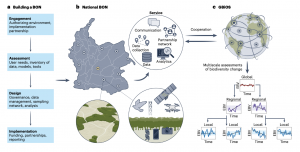Essential Biodiversity Variables (EBVs): Opportunities for space-based EO
In 2024, the CEOS Chair, the Canadian Space Agency (CSA), has chosen to prioritise biodiversity monitoring from space. Over the course of 2024, a series of articles will be published here to support the Chair’s goals, and highlight the importance of Earth observations (EO) for Biodiversity. Please see here for other articles in the series.
Biodiversity, the variety of life on Earth, is essential for the health and resilience of ecosystems and the well-being of humanity. Monitoring biodiversity is important for understanding ecosystem dynamics, assessing the impacts of human activities, and informing conservation efforts. Biodiversity is under increasing pressure from various anthropogenic activities such as habitat destruction, climate change, pollution, invasive alien species, and overexploitation of natural resources. To effectively conserve biodiversity, it is essential to monitor its status and trends over time.
Traditional methods of biodiversity monitoring often face challenges such as limited spatial and temporal coverage, high costs, and logistical constraints. Space-based EO offers a solution by providing comprehensive and consistent data on the Earth’s surface at various spatial and temporal scales. EO technologies, including satellite remote sensing, airborne sensors, and ground-based instruments, enable the acquisition of valuable data on key biodiversity parameters such as land cover, ecosystem extent and condition, habitat fragmentation, species distribution, and ecosystem dynamics. These data allow scientists, policymakers, and conservation practitioners to monitor biodiversity at global, regional, and local scales, facilitating evidence-based decision-making for conservation and sustainable development initiatives.
Based on the concept of the successful Essential Climate Variables (ECVs), Essential Biodiversity Variables (EBVs) are a set of parameters that capture key aspects of biodiversity, from genetic diversity to ecosystem structure and function. Essential Ecosystem Service Variables (EESVs) provide a set of measures required to quantify the investments people make and the benefits society receives from ecosystems from local to global scales. Developed by the Group on Earth Observations Biodiversity Observation Network (GEO BON), EBVs and EESVs provide a standardised framework for biodiversity monitoring, allowing for comparability and interoperability of data across different regions and ecosystems. EBVs are grouped into classes, including genetic composition, species populations, species traits, community composition, ecosystem functioning and ecosystem structure. GEO BON has also established the EBV Data Portal to host a variety of EBV raster datasets. The portal currently contains 40 datasets, and new datasets can be uploaded by users at any time.
Ecosystem Structure is one class of EBVs, including the variable ‘Ecosystem Distribution’, also known as ecosystem extent. Space-based EO data is the primary input for this variable and hence where CEOS has focused its initial efforts. The GEO Ecosystem Atlas, now in its early stages of development, will be a key user of this EBV. Many indicators of biodiversity and its sustainable use, such as those used by the UN Convention on Biological Diversity (CBD) to assess progress towards the goals and targets of the Kunming-Montreal Global Biodiversity Framework, are based on EBVs. While conceptual workflows are available for many EBVs and the indicators derived from them, considerable additional work is needed to develop, refine and, in particular, operationalise EBVs and indicators so these key products are created and made available for users.
The CEOS Ecosystem Extent Task Team (EETT) was formed in December 2022 with a two-year mandate, focusing on producing a white paper on “Space-based Earth Observation and Ecosystem Extent” in 2023 and developing three demonstrator projects in 2024. The three demonstrator projects are exploring the use of satellite EO data for mapping and measuring ecosystem extent, supporting the Ecosystem Distribution EBV. Although EETT’s formal mandate ends in October 2024, CEOS is likely to continue its work on exploring ways to support biodiversity in the future.
GEO BON and its partners are developing the concept of a Global Biodiversity Observing System, known as GBiOS, to serve as a global network of national Biodiversity Observation Networks (BONs). BONs are a foundational component of GBiOS and will provide many of the observations needed to support the EBVs and the biodiversity indicators used by international agreements such as the KM-GBF and SDGs. A BON interlinks biodiversity observing technologies, EBV and EESV data repositories, knowledge platforms, and stakeholders that facilitate the production, exchange, integration, and sharing of biodiversity data and information. GBiOS will serve as a key link between EO data providers, biodiversity researchers, and decision-makers, enabling the integration of space-based EO data into biodiversity monitoring and assessment activities.

